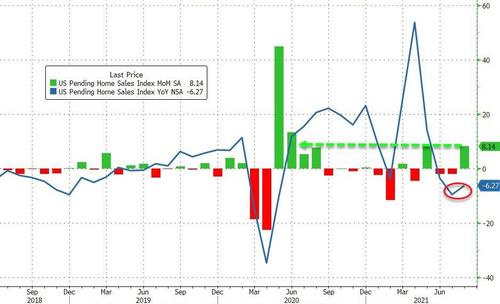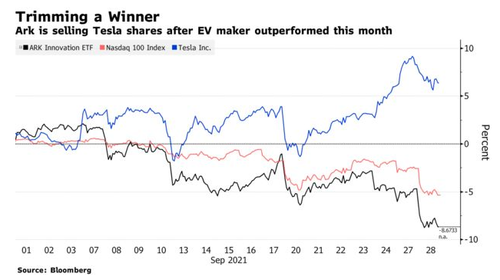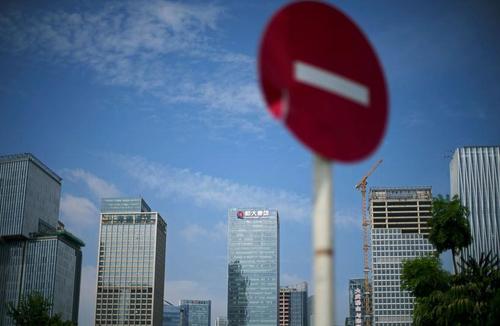Rabobank: Warren Is Right, Powell Is Dangerous… So Is The Whole Fed
By Michael Every of Rabobank
Tuesday was ugly in markets. US equities tumbled around 2% to a two-month low and through key moving averages, with even the biggest names falling. US Treasury yields also continued to rise, with 2s little changed, 5s up 3bp, and 10s up 6bp, marking further curve steepening. The US dollar got another lift as gold and crypto saw another dip. Reflation? Stagflation? Devastation?
In Europe, gas prices went vertical (up 12%), then fell, and ended slightly higher. This underlines the precariousness of the global energy complex, with all the knock-ons that entails. The only “reassurance” came from the Kremlin, which stated that despite a further drop in gas shipments to the EU, this was temporary, and Russia “would never use gas as a weapon. Really. Honest. Pinky swear. Now when does Nord Stream 2 get signed off on by Europe?”
In keeping with Bond themes, and it was also finally time for ‘No Time To Die’, other bangs were heard in DC. Treasury Secretary Yellen emphasized the cash runs out on 18 October, the US government will shut down, and could default on its debts, which would be “catastrophic”. Of course, that can be avoided if the Democrats raise the debt ceiling, which they have the votes to do, even over a Republican filibuster, by using ‘reconciliation’. However, they don’t want to: it takes weeks of painful committees at best. The debt ceiling could be linked to other bills – but the Democrats don’t have the votes for them. Progressives oppose the bipartisan $1.2trn infrastructure bill alone, including AOC. (Who, without being partisan, just someone who enjoys play on words, I just heard intellectual honey badger Gad Saad call “Occasional Cortex” – few of which are being displayed by either party.) Moderates won’t vote for the $3.5trn Build Back Better Bill. This is all boring and explosive in equal measure – probably like ‘No Time To Die’(?)
So was testimony from the Fed’s Powell, who came closer to admitting he doesn’t understand what is going on with global supply chains. That was underlined by him saying the logistical snarls behind the surge in inflation have actually worsened (No!); that this is all broader and more structural than earlier this year (Never!); but it is only seen in a very limited number of items (Does he base this on looking at CPI and used cars?!); and it will wane in the foreseeable future (“because DSGE models”?). If you read supply-chain news, they think differently – and more so if US stimulus bills are eventually passed: Maersk says “demand must ease” to resolve matters.
Other shooting saw a Senator suggest a bill to ban Fed stock trading –what about for members of Congress?– and then Senator Warren oppose Powell’s renomination for a second term as Fed Chair, calling him a “dangerous man”. Well, I did ask yesterday if it would be a clean sweep of Rosengren, Kaplan, and Powell…. Looking at the Fed Chair, I see Jerry English rather than any Bond. But bumbling fools blow things up too. Indeed, the danger lies in bonds; and loans; and derivatives; and crypto; and QE – though it was specifically Powell’s watering down of post-financial crisis bank regulations that triggered Warren to pull her trigger.
Let’s presume the debt ceiling will be raised and catastrophe avoided. Yet what are the odds of fiscal stimulus, and what supply-chain chaos will it unleash if so? The Fed has seen two members depart under a cloud, and the FOMC Chair will have one hanging over him even if he is reappointed. Said Fed Chair is not close enough to admitting supply chains are structural, not cyclical, and won’t be resolved in days, weeks, or months, but years. And we still might get a new Fed Chair who is more open to regulation –and more QE/MMT– than the one we have now.
It needs to be underlined yet again that without wage growth, current inflation — as US house price growth hits 20% y/y! — is destructive of demand. As our rates strategy team points out, that argues for yield-curve flattening, not steepening. Indeed, that demand destruction is going to blow up a lot more than just GDP growth given the current socioeconomic backdrop. Have you felt the ugly vibe on the street? Want to throw a 1970’s style energy supply-shock recession into the mix and see what happens? As such, this demand destruction may be delayed by governments subsidizing energy prices and/or by consumer credit, even in debt-addled economies. And how about if we add more QE (or MMT with yield curve control) into the cauldron and stir?
That’s an argument for a pre-Covid ‘new normal’ curve flattener. Except this time inflation would be structurally high, not low until new supply chains that can cope with current, or future, demand are in place – which is years away; if we knew where to start; which politicians don’t, or won’t act on.
Even then one can argue in favor of lower bond yields because ultimately there is no way governments or central banks will allow markets to point out just how wrong they have been: think of those looming energy subsidies as we head into a ‘green transition’; or of Euro peripheral yields, and the obvious politics over fundamentals at play there (“The woman from the ECB – she says yes!”). What this implies for FX rates over time is a different matter. It depends who has the supply chains and who doesn’t.
We are not living in a DSGE model, but a complex system. If supply chains are as in much trouble as some supply-chain experts say they are, with the risk of a cascading failure that ends up with the army delivering fuel, etc., things can get ugly fast: who saw gas prices doing what they are nine months ago? Prices will not rise a little, and demand adjust down a little, and all be well again in a few quarters mechanistically, as central banks think. If we pass the logistical equivalent of the ecological 3- or 4-degrees Celsius temperature increase we worry about, goods will get more expensive, and people poorer/in debt. Yes, we can repress market pricing for bonds if we want against that backdrop – in fact I am sure we will. We can also repress pricing in FX if we want – some already do. There just won’t be any real markets left in the end. History is replete with examples of this: go live in an emerging market, or talk to people who have lived in them.
For just one example, I recall back Russia in 1994, the Moscow wanted to increase the price of the plastic zhetons then used to ride the metro system (copies of an old Soviet coin). As soon as the rumour hit, hoarders bought all the zhetons. Nobody else could then ride the metro, as none were for sale. The Moscow municipality had to order new zhetons from abroad, given no local supply, and at a high cost given a weak Ruble. What was supposed to be a revenue-raising exercise ended up losing money and pushing up travel costs, with a knock-on effect on other prices in Moscow. This kind of ‘let’s assume supply’ idiocy is already at work in an economy near you.
So, yes, Warren is right. Powell is dangerous. So is the whole Fed; and other central banks; and the whole of Congress; and our global neoliberal obsession with free-market economies of scale, near-term cost-saving, and de facto monopoly/oligopoly centralisation over fail-safes and resiliency; and people trading and hoarding digital farts like zhetons. They are ALL dangerous.
And things can get much more dangerous ahead for all of us if appropriate policy responses are not made – which are not the ones the market is endlessly talking about
Tyler Durden
Wed, 09/29/2021 – 10:15
via ZeroHedge News https://ift.tt/3m9uobh Tyler Durden













